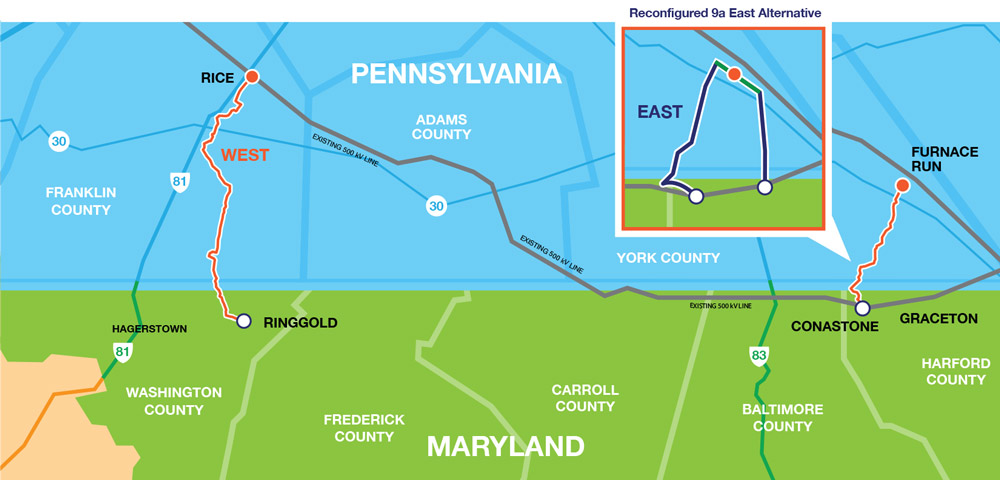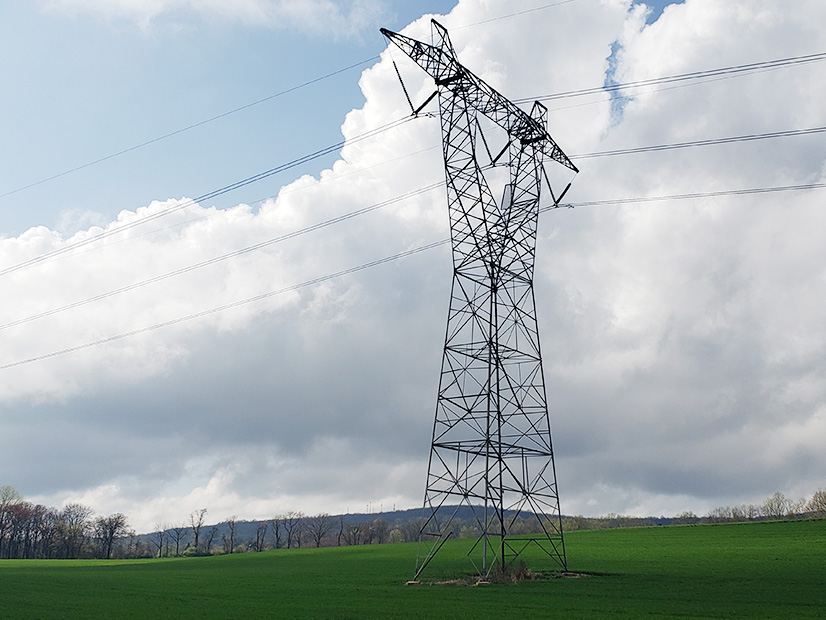Transource Energy has appealed the Pennsylvania Public Utility Commission’s decision to reject the controversial Independence Energy Connection (IEC) transmission project between the commonwealth and Maryland.
The Columbus, Ohio-based company, made up of a partnership between American Electric Power and Evergy, filed two different challenges last week — one in the U.S. District Court for the Middle District of Pennsylvania and another in the Commonwealth Court of Pennsylvania — against the PUC and its four commissioners (1:2021cv01101).
The PUC voted 4-0 during its public meeting last month to reject a series of related applications and petitions filed by Transource for the siting and construction of high-voltage electric transmission lines in Franklin and York counties. The PUC denied the project based upon concerns about whether the need established in the PJM planning process met the requirement for needs specific to Pennsylvania. (See Transource Tx Project Rejected by Pa. PUC.)
PJM selected Transource’s market efficiency proposal in August 2016 to reduce congestion along the RTO’s AP South interface. The congested interface was included in PJM’s inaugural window for proposing market efficiency projects as part of the RTO’s implementation of FERC Order 1000.
“New transmission infrastructure is necessary to incorporate new energy sources into the market while maintaining system reliability, and the evidence clearly demonstrates that multistate regional planning is the most effective way to meet these needs,” said Brian Weber, Transource senior vice president.
Court Filings
In its filings, Transource said PJM’s determination of need for a project is the requirement that should be followed to operate a multistate regional transmission system efficiently and reliably. The company said the PUC determined the lines were not needed because eliminating the bottleneck would primarily help out-of-state customers and raise wholesale energy prices paid by Pennsylvania customers.
Transouce said the PUC’s decision to reject the siting applications violated two separate constitutional constraints on state action. In the first case, the company said Pennsylvania’s decision to deny the applications was pre-empted by federal law because the state’s “broad authority over siting determinations” does not allow the overruling of a determination made under federal law that the interstate transmission system needs a new line.
“The authority claimed by the PUC — to deny that a line is needed when the federally authorized transmission planning process has reached a contrary conclusion — improperly second-guesses the result of a federally approved process and is an obstacle to achievement of national policy and FERC’s regulatory authority over the interstate transmission system,” Transource said in its filing. “If a state can determine that local, parochial interests allow it to reject a regional determination of need, regional transmission planning will be effectively impossible.”
Transource also argued that the PUC’s decision violates the dormant Commerce Clause, the legal doctrine that the Constitution prohibits states from regulating interstate commerce, a power prescribed to Congress. The company said the PUC’s ruling blocked the construction of an “interstate channel of commerce” that would allow less expensive energy produced in Pennsylvania to flow out of the state and reach the broader market.
Transource said the commerce clause also bars states from “imposing burdens” on interstate commerce that outweigh local benefits.
“The court cannot allow a state to point to the local economic benefits that result from interstate transmission congestion as the justification for blocking a project needed to alleviate congestion and benefit the entire region by improving the efficiency of the electric grid,” Transource said in its filing.
Project’s Status
Transource’s transmission line proposals, known as the IEC East and West projects, have gone through several rounds of litigation and investigation since they were first brought to the PUC and other state and federal agencies in 2017. The project got the go-ahead with a certificate of public convenience and necessity from the Maryland Public Service Commission last June. (See Md. PSC OKs Independence Energy Connection Deal.)

Transource’s plan for the eastern section of the project originally called for extending 15.8 miles of transmission lines from a new Furnace Run substation in York County, Pa., to the Conastone substation in Harford County, Md. By October 2019, an updated configuration designed in consultation with PJM increased the size of the new substation in Pennsylvania and added 4 miles of lines connecting to an existing right of way that would feed into two upgraded Baltimore Gas and Electric substations. (See Transource Files Reconfigured Tx Project.)
The western segment of the IEC project includes a 230-kV double-circuit transmission line running 28.8 miles from Franklin County, Pa., into Washington County, Md.
Transource said the project is expected to create 130 full-time jobs and support $40 million in local economic activity.
But from early in the project, local landowners challenged Transource and PJM on the necessity of the transmission lines, creating community groups to protest and challenge the project in court. (See Protesters Doubt PJM Analysis of Transource Alternative.)
In December, PUC Administrative Law Judge Elizabeth Barnes issued her recommended decision on the project, citing 233 findings of fact and 16 conclusions of law. In her decision, which was ultimately adopted by the PUC, Barnes said she was “not persuaded” that Transource had carried the burden by a “preponderance of the evidence” to establish need after viewing the evidence of the case and finding the opposing arguments made by local landowners to be “more persuasive.”
Barnes ultimately concluded that data used by PJM regarding congestion on the AP South interface were “not reliable enough to form the basis of need” for the project. (See PJM Analysis of Transource Alternative Challenged.)

